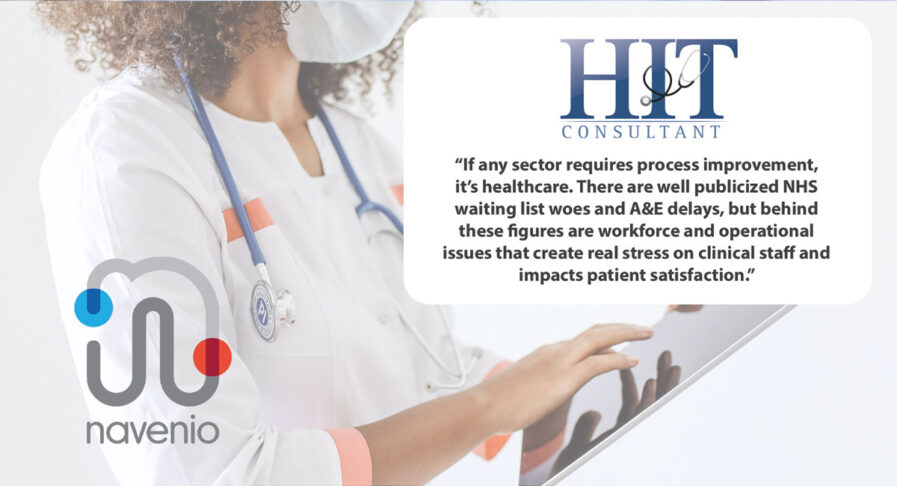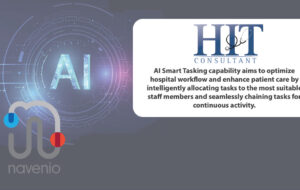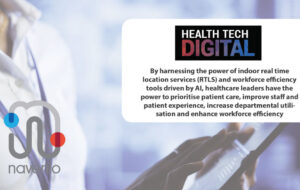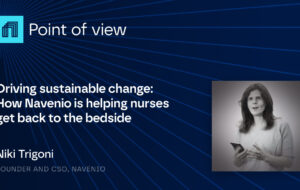HIT Consultant: Efficiently Sustainable: How Hospitals Can Create Operational Sustainability

By Connie Moser, Chief Executive Officer, Navenio, published by HITConsultant.net
If any sector requires process improvement, it’s healthcare. There are well publicized NHS waiting list woes and A&E delays, but behind these figures are workforce and operational issues that create real stress on clinical staff and impacts patient satisfaction.
Nurses spend 10% of their time searching for equipment (according to a 2009 study) and sadly little has changed in more than a decade. Another study also revealed nurses claim that they experience “16-30% preventable wasted time during the shift”, with the most contributing factors including waiting for “lab data responses, transfer of patients, or delivery of care”.
With an ageing nursing population and less experienced nurses making up a larger portion of the nursing staff, it is more important than ever to improve process design into structured, efficient care flow practices within the hospital. Nurses need to be empowered to do their jobs efficiently and hospitals need ways of building sustainability into their operational improvement efforts.
However, current levers of change are failing to deliver necessary continuous improvements. Consultants are brought into redesign processes, but six months later everything returns to stasis. Change in a healthcare context has become inconsistent and unsustainable.
What creates sustainability of any process change is some level of infrastructure to support the process and access to real-time data to determine if the change is working. And currently, data is nearly impossible to obtain on a real-time ongoing basis especially in a hospital setting given the diversity of systems supporting operational and clinical workflow.
Why does process change typically fail?
Process change tends to stick when it has tangible – or, in some cases, perceived – benefits. If the change will make an employee’s job easier, for example, or it eliminates parts of their job they don’t like or deem low value, then it is much more likely to take hold. But if process change fails to meet this expectation, then the opposite happens.
Unfortunately, the deployment of electronic health record (EHR) systems in many cases, created more work for clinicians not less and gave a black eye to Six Sigma – a framework of tools for achieving process change – in hospitals.
Despite 90% of NHS trusts now using an EHR, the British Medical Journal also discovered that the majority are still using paper for many other processes. It is this mixture of methods and change approaches that can add strain to staff workloads, not improve them, and also frustrate attempts to create a unified system and process.
What is sustainable process change – and what sabotages it?
Sustainable process change requires building operational sustainability into the overall effort, allowing hospitals to optimize resources in real-time, operate within their means and flex for incremental capacity increases. To do this, they need to introduce new methods for facilitating patient flow, allocating staff and resources, and conducting overall coordination and management. With only paper and people to address process change, permanent change is difficult, however with the right technology-based tools to offer infrastructure to facilitate change permanent, repeatable processes and data are possible.
A revealing survey published by the BMA last month showed how new initiatives can sabotage sustainable change when introduced incorrectly: doctors reported that working with new associates designed to free up their time to focus on patient care was doing the opposite and increasing their workloads. It highlights how increased workloads are not stemming from resource inadequacies alone but from process and operational inefficiencies.
Regarding technology, another BMA survey estimated that “13.5 million working hours are lost annually in England due to inadequate information technology (IT) systems and equipment in the NHS”. Management needs to better understand employee needs to introduce initiatives and hospitals need an easy-to-integrate and central IT system that can drive process change in a sustainable and unified way.
How can nursing technology drive sustainable improvements?
A new concept called Reverse Bed Chain (RBC) is looking to address these failures. RBC drives process improvement by giving nurses tools to fuel activity and optimize resources. Through real-time location services technology (RTLS) as an addition to existing systems, the strategy provides a hub of real-time data that allows for the optimal allocation of staff and resources. How does it do this?
Essentially an Uber for healthcare, staff can access an intelligent workforce app via their smartphones which can track the location of patients, staff and equipment in real-time. This means staff and resources can be smartly allocated to where they are most needed (depending on what is physically closest to the necessary location) and patients can be moved through the hospital most efficiently.
This gives nurses the freedom to proactively drive care and helps build overall operational efficiency: patient flow happens more efficiently, staff can access patient information as and when needed, and managers have oversight on trends and can plan more effectively.
The winning approach
Data itself has not been an issue in healthcare – instead, it’s the siloed nature of data in unusable formats, making real-time data collection and access nearly impossible. The lack of data-driven processes makes it harder to move patients efficiently and allocate resources effectively.
Access to real-time data is a requirement for building sustainable change. RBC combines process change strategies with technology to deliver significant efficiencies, using real-time data to optimize hospital resources and allow nurses to proactively carry out care. There’s no burst of activity and then a return to previous processes – alongside broader management and coordination strategies, the process lays a foundation for building operational sustainability.
If clinical and non-clinical staff can’t see the visible or perceived impact of process change, it is likely to fail in its mission. The key to unlocking process change is finding ways to give nurses the power to drive processes that follow evidence-based protocols and allow them to see and document the impact – that’s the winner.
About Connie Moser
Connie Moser is a serial entrepreneur with several successful exits to her credit and more than 30 years of experience building healthcare information technology organizations. Connie is known industry wide as a true leader who relentlessly pursues growth through realized customer value, all while building loyal teams that routinely follow her to new opportunities. Connie’s success is data-driven, accomplished through validated growth metrics gained via strategic acquisitions, effective sales bundles, and business process streamlining through automation. As the Chief Executive of Navenio, a UK-based technology company focused on logistical intelligence in healthcare, she is validating her leadership skill with successful revenue transactions as she did as the CEO of Verge Health (now RLDatix) and building a strong presence in the US and global healthcare market. Team empowerment and mentoring younger employees has been a constant throughout her lengthy career and a source of deep satisfaction. Her mentorship extends to her work as a long-time board member of her alma mater Ripon College since 2013.




